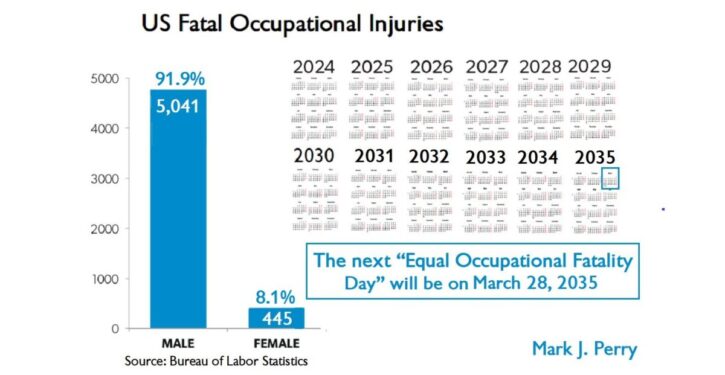
Men are much more likely to work in dangerous jobs than women are, and men work more hours on average than women do, even when you compare only men and women working “full-time” jobs.
Yet today is declared “Equal Pay Day” to criticize the fact that women are paid less on average than men, a complaint that ignores differences in occupational hazards and hours worked for men and women.
A progressive think-tank complains that “Data from 2022 show that the median annual earnings for women working full time, year-round was $52,360, or just 84 cents for each dollar earned by men.”
Economist Mark Perry — a professor emeritus of the University of Michigan — criticizes such complaints for advocating equal pay for unequal work:
The bogus feminist holiday “Equal Pay Day” … falsely assumes how far into 2024 the typical woman has to work to earn what her alleged male counterpart earned in 2023, based on median female earnings being 14% below median male earnings, and assuming that the entire 14% earnings gap is due to sex discrimination. But male and female workers are significantly different in terms of hours worked (men work more), years of continuous work experience without interruptions (women take more time off), types of jobs selected including the fact that men are much more willing than women to work in high-risk, dangerous jobs with greater risk of injury or death. Based on the fact that men are 11X more likely to die on the job, I calculate that the next “Occupational Fatality Day” is March 28, 2035, which represents the reality that women can work for the next 11 years before they experience the same number of job fatalities as male workers last year (5,041).
A key reason women earn less than men on average is that women work fewer hours on average than men even when they work full-time. As Washington Post fact-checker Glenn Kessler noted in 2013, government data show women work fewer hours than men, which explains much of the apparent pay gap: “Since women in general work fewer hours than men in a year, the [pay gap] statistics used [to push for passage of the proposed Paycheck Fairness Act] may be less reliable for examining the key focus of the legislation — wage discrimination.”
Similarly, Ramesh Ponnuru noted at Bloomberg News that the pay gap between men and women “reflects the fact that women, on average, work fewer hours than men.” Family responsibilities also play a role. Economist Diana Furchtgott-Roth cited a 2005 study which found that “there is no gender gap in wages among men and women with similar family roles.” In addition to being more likely to seek part-time work, women are also more likely to have gaps in their employment history and to enter lower-paying fields, she notes, and “a 2009 report for the Labor Department found that these factors account for most of the pay gap.”
Moreover, women have, on average, better fringe benefits than men. As Diana Furchtgott-Roth notes, if you control for hours worked and fringe benefits, most of the wage gap disappears. Predominantly-female occupations like teachers often have good retirement benefits and good healthcare benefits, compared to heavily-male occupations.
It’s obvious that employers don’t pay women 20% less for the same work. If they did, employers could (and some would) crush their competitors by hiring only women, who cost less to employ, to reap a huge cost advantage. But no major employer has ever done so. As one commenter notes, if this massive pay disparity actually existed, “why wouldn’t any company seeking to enhance its competitive position (i.e., all of them) simply hire only women? After all, such a company could offer, say, 90 cents and attract untold numbers of female applicants for employment and still have a distinct advantage in the cost of its labor.” The supposed 20% pay disparity is vastly bigger than the profit margin of most major companies — grocery store chains often have a 1% profit margin.
Misconceptions about the wage gap between men and women are driving support for the Paycheck Fairness Act, which could require equal pay for unequal work in some cases. In 2009, an unnecessary law called the Lilly Ledbetter Fair Pay Act was enacted based on false claims about the facts and ruling contained in a Supreme Court decision dealing with pay discrimination. (The Ledbetter Act extended the statute of limitations for suing over pay discrimination, under one of the existing laws banning pay discrimination, Title VII of the Civil Rights Act of 1964. It was unnecessary because another law, the Equal Pay Act, already had a longer deadline for suing, that gave women plenty of time to sue over pay discrimination. Lilly Ledbetter lost her lawsuit because she argued her pay discrimination claim under the law with the shortest deadline for suing.).
As House Speaker Nancy Pelosi (D-Calif.), a supporter of the Paycheck Fairness Act, noted, under the Equal Pay Act that is currently in force, “Courts have allowed employers to use any factor other than sex to justify a pay disparity between men and women.” By contrast, she said, “Under the Paycheck Fairness Act, an employer would have to show that the disparity … is job-related, and is consistent with business necessity.” In her view, the fact an employer relied on a “factor other than sex” to set pay, and was not motivated by sexism in setting pay, should not be a legal defense. The Society for Human Resource Management, which disagrees with Pelosi, contends that the Paycheck Fairness Act “would effectively prohibit employers from using many legitimate factors to compensate their employees, including professional experience, education, training, employer need, local labor market rates, hazard pay, shift differentials and the profitability of the organization.”
Supporters of the Paycheck Fairness Act tend to assume that pay disparities are the result of gender bias. But many disparities reflect the fact that men and women often choose very different lines of work, with men disproportionately represented in some of the nastiest and most dangerous jobs. According to the federal Bureau of Labor Statistics, 92% of all workers who die on the job are men. As Steve Tobak noted at CBS News back in 2011,
Men are far more likely to choose careers that are more dangerous, so they naturally pay more. Top 10 most dangerous jobs (from the U.S. Bureau of Labor Statistics): Fishers, loggers, aircraft pilots, farmers and ranchers, roofers, iron and steel workers, refuse and recyclable material collectors, industrial machinery installation and repair, truck drivers, construction laborers. They’re all male-dominated jobs. … Men are far more likely to take work in uncomfortable, isolated and undesirable locations that pay more. Men work longer hours than women do. The average fulltime working man works six hours per week or 15 percent longer than the average full-time working woman.



